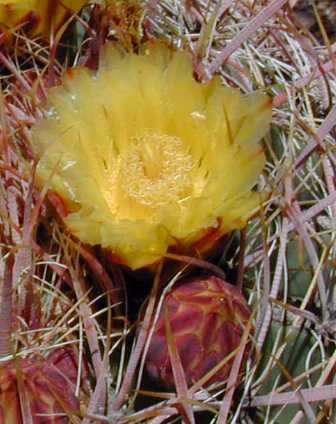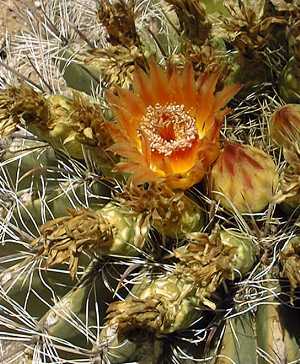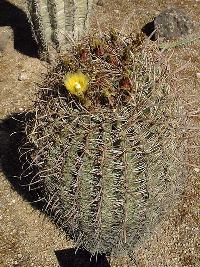Compass Barrel Cactus
Scientific Name: Ferocactus cylindraceus (Engelm.) Orcutt
Synonym: Echinocactus acanthodes var. rostii , Echinocactus acanthodes, Echinocactus cylindraceus, Echinocactus hertrichii, Echinocactus rostii, Echinocactus viridescens var. cylindraceus , Ferocactus acanthodes, Ferocactus acanthodes var. rostii , Ferocactus rostii, Thelocactus hertrichii
Family: Cactaceae
Sunset®: 8-24
USDA: 9-10
Frost Tolerance: Hardy to 20° F. (-7°C)
Sun Exposure: Needs full sun
Origin: Southwest USA(Arizona, California), northern Mexico (Sonora, Baja California) at 2000 to 5000 feet elevation (600-1500 m)
Growth Habits: Solitary, grows slowly to 8 feet tall (2.4 m), 14 inches in diameter (35 cm); 18 to 25 obtuse ribs; Areoles are 0.6 to 0.8 inches apart (1.5 to 2 cm); 1 to 4 central spines, generally 2 are longer, one upper and one lower, curved but not hooked, 3 to 4.5 inches long (7.5-11 cm); 6 to 12 white spreading radial spines, 0.8 to 1.6 inches (2-4 cm).
Watering Needs: Little water in a moderately rich, well drained soil. Ferocacti die easily with too much water or not enough sun.

This cactus was known for years as Ferocactus acanthodes, until the name was found invalid. The valid name is now F. cylindraceus.
The Compass Barrel Cactus grows slanted in the direction of the south. This is due to the fact that the northern side in the cactus, somewhat protected from the sun grows faster than the south side. The picture is taken from the south side.
The different varieties are distinguished by the shape and color of the spines, although the spine color can vary widely within the same population.

Blooming Habits:
The Compass Barrel has yellow or orange flowers in may through August, 1.6 to 2 cm (4-5 cm).
Culture:
Ferocactus cylindraceus needs little water in a moderately rich, well drained soil. Ferocacti die easily with too much water or not enough sun. They come from an area that receives winter rain, so some limited rain in early spring is fine, but in habitat, the soil around them is bone dry most of the year.
Desert-Tropicals is dedicated to provide gardening advice, gardening ideas, and information about flower of all kind for landscape and collections.We try to check carefully the identification of the plants on the illustrations as well as the other information from the page, but occasionally errors do occur. if you notice anything that needs to be changed please contact us.Thanks.
© 1998-2020 Philippe Faucon, All Rights Reserved.
